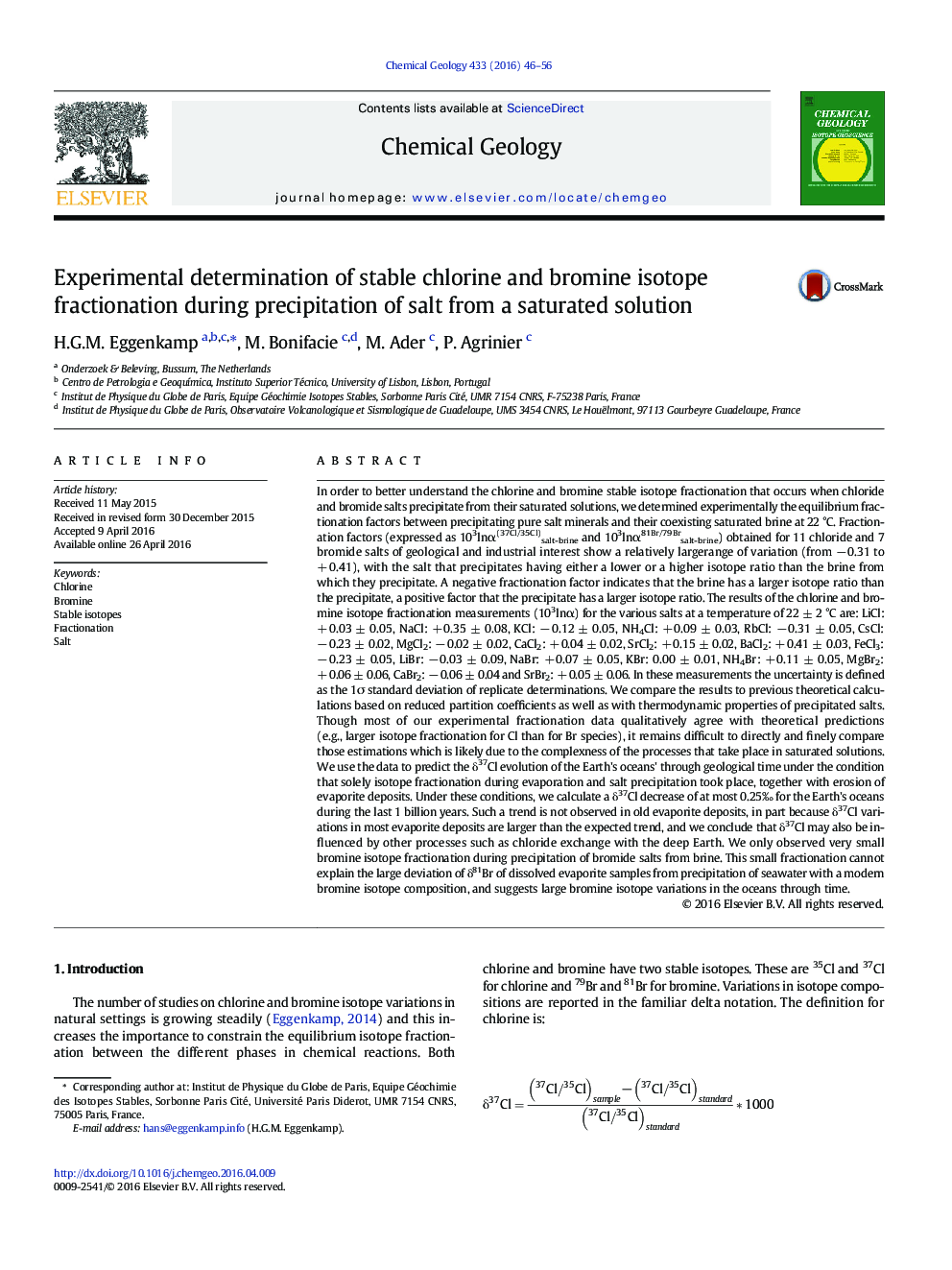| کد مقاله | کد نشریه | سال انتشار | مقاله انگلیسی | نسخه تمام متن |
|---|---|---|---|---|
| 4698230 | 1637541 | 2016 | 11 صفحه PDF | دانلود رایگان |
• Large variations are observed for Cl isotope fractionation during precipitation of salt minerals
• Fractionation is dependent on the co-precipitating cation
• In bromide salts, Br isotopes show much smaller fractionation, but it is also dependent on cations
• Simulation of historical δ37Cl of the oceans (based on salt deposition/erosion) shows a 0.25‰ decrease since the Ediacaran
In order to better understand the chlorine and bromine stable isotope fractionation that occurs when chloride and bromide salts precipitate from their saturated solutions, we determined experimentally the equilibrium fractionation factors between precipitating pure salt minerals and their coexisting saturated brine at 22 °C. Fractionation factors (expressed as 103lnα(37Cl/35Cl)salt-brine and 103lnα81Br/79Brsalt-brine) obtained for 11 chloride and 7 bromide salts of geological and industrial interest show a relatively largerange of variation (from − 0.31 to + 0.41), with the salt that precipitates having either a lower or a higher isotope ratio than the brine from which they precipitate. A negative fractionation factor indicates that the brine has a larger isotope ratio than the precipitate, a positive factor that the precipitate has a larger isotope ratio. The results of the chlorine and bromine isotope fractionation measurements (103lnα) for the various salts at a temperature of 22 ± 2 °C are: LiCl: + 0.03 ± 0.05, NaCl: + 0.35 ± 0.08, KCl: − 0.12 ± 0.05, NH4Cl: + 0.09 ± 0.03, RbCl: − 0.31 ± 0.05, CsCl: − 0.23 ± 0.02, MgCl2: − 0.02 ± 0.02, CaCl2: + 0.04 ± 0.02, SrCl2: + 0.15 ± 0.02, BaCl2: + 0.41 ± 0.03, FeCl3: − 0.23 ± 0.05, LiBr: − 0.03 ± 0.09, NaBr: + 0.07 ± 0.05, KBr: 0.00 ± 0.01, NH4Br: + 0.11 ± 0.05, MgBr2: + 0.06 ± 0.06, CaBr2: − 0.06 ± 0.04 and SrBr2: + 0.05 ± 0.06. In these measurements the uncertainty is defined as the 1σ standard deviation of replicate determinations. We compare the results to previous theoretical calculations based on reduced partition coefficients as well as with thermodynamic properties of precipitated salts. Though most of our experimental fractionation data qualitatively agree with theoretical predictions (e.g., larger isotope fractionation for Cl than for Br species), it remains difficult to directly and finely compare those estimations which is likely due to the complexness of the processes that take place in saturated solutions. We use the data to predict the δ37Cl evolution of the Earth's oceans' through geological time under the condition that solely isotope fractionation during evaporation and salt precipitation took place, together with erosion of evaporite deposits. Under these conditions, we calculate a δ37Cl decrease of at most 0.25‰ for the Earth's oceans during the last 1 billion years. Such a trend is not observed in old evaporite deposits, in part because δ37Cl variations in most evaporite deposits are larger than the expected trend, and we conclude that δ37Cl may also be influenced by other processes such as chloride exchange with the deep Earth. We only observed very small bromine isotope fractionation during precipitation of bromide salts from brine. This small fractionation cannot explain the large deviation of δ81Br of dissolved evaporite samples from precipitation of seawater with a modern bromine isotope composition, and suggests large bromine isotope variations in the oceans through time.
Journal: Chemical Geology - Volume 433, 1 September 2016, Pages 46–56
